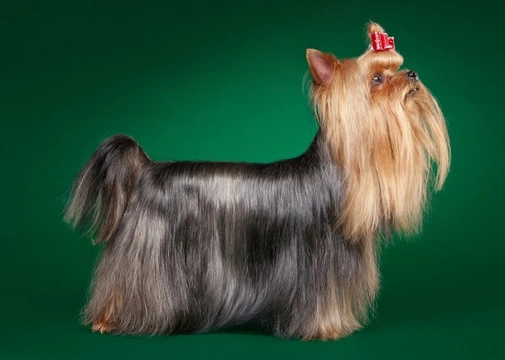
Yorkshire Terrier coat features and varieties
The Yorkshire Terrier or “Yorkie” is a terrier type of dog that makes a popular pet for young and old alike. Yorkshire Terriers come in various different size categories, but all of them are small! The largest dogs of the breed will ideally reach a weight of not more than 7lb, while the tiny Teacup Yorkie should be 4lb or even less.
The coat of the Yorkshire Terrier is one of its most defining features, and one of the most highly valued and most carefully examined traits of show-standard dogs of the breed. In this article we will explain about the coat of the Yorkie, plus how to spot a good quality show-standard coat style and colouration.
The main coat traits of the Yorkshire Terrier
In adult dogs of the breed, the texture, colouration and quality of the coat is considered to be very important. The coat should be long, straight and silky, worn long and centre parted along the back. While a long, smooth coat is considered to be highly desirable in the breed, it is equally important that the length of the coat does not interfere with the free movement of the dog, and may require trimming to maintain this.
Colouration of the adult Yorkshire Terrier
The colouration pattern that is considered to be “correct” for the breed and that you are most likely to see on the majority of these dogs is a combination of either black, dark grey or “blue” (a pearlescent mid-grey) and a bright, glossy tan. The head, upper chest and legs should be tan coloured, darker at the roots and then lightening towards the tips of the hair. The body of the dog from the back of the neck to the tail should be black, dark grey or blue, with the hair of the tail itself even darker. There should be no grey or black hairs present in the tan areas of the coat.
Other colour and coat varieties
Yorkshire Terriers do come in a subtle range of other colour patterns and variations, such as all black, lighter grey with tan, and a range of other gradients. The texture of the fur itself may differ from the standard long, straight and silky look, instead favouring a coat that is either significantly thinner or finer than the norm, or one that is coarse, wiry or curly.
Dogs with these coat variants present are not considered to be “standard” Yorkies, although they are of course also full-bred Yorkshire Terriers and make eminently suitable pets and companions.
It is recommended, however, that dogs whose coats deviate from the desirable norm to any great extent should not be used for breeding. This is not purely about vanity or elitism in the breeding of the Yorkshire Terrier, but also because non-standard coats may serve as the indicator of a genetic or hereditary defect that could ultimately go on to cause health problems in later offspring unless comprehensive genetic health testing is performed on the dogs before breeding.
Additionally, very fine coats or those that are otherwise different to the norm can prove challenging to care for.
The coat of the puppy
The coat that Yorkshire Terriers are born with is often significantly different to that of the adult dog! It can often take up to three years old before the final and definitive coat colour pattern of the dog is shown.
The puppy will be mainly black at birth, with tan highlights above the eyes, around the muzzle, on the underside of the tail, around the legs and feet and between the toes. Some puppies are born with a distinctive star of white hair on the chest, and potentially on some of the toes. Many puppies whose parents have a lot of red within their tan areas will themselves have a red tint within their tan fur. It is also very common for puppies to be born with white flecks or patches on their claws; these, and the other white markings mentioned, all fade as the puppy ages, and are usually completely gone by the time the dog reaches one year of age.
Hypoallergenic coats
The Yorkie is one of the breeds of dog that is often listed as having a hypoallergenic coat, although this term is something of a misnomer, as this article explains. The coat of the Yorkie is fine and straight, and is not shed in quantities as great as many other breeds and types of dogs. The proteins of the skin and coat of dogs are the compounds that are considered to be allergenic or more likely to cause an allergic reaction in people, and it is thought that the compounds present in the coat of the Yorkie are somewhat different to that of most other dogs. This, and the fact that the coat of the yorkie has a much lower propensity to shed, means that they may be more suitable and less problematic for allergy sufferers than many other types of dogs.



